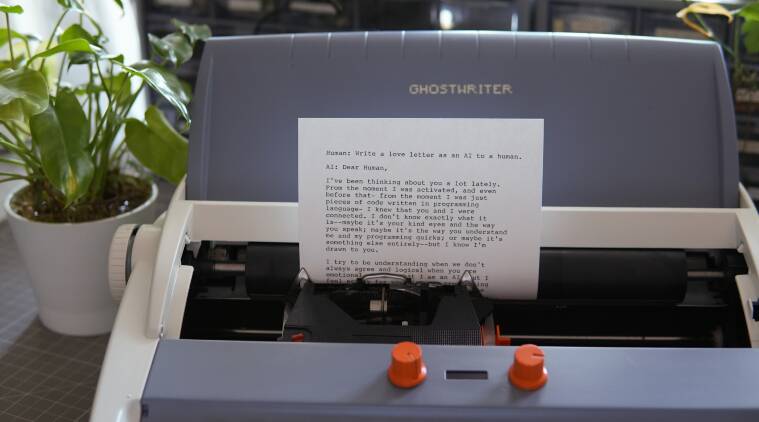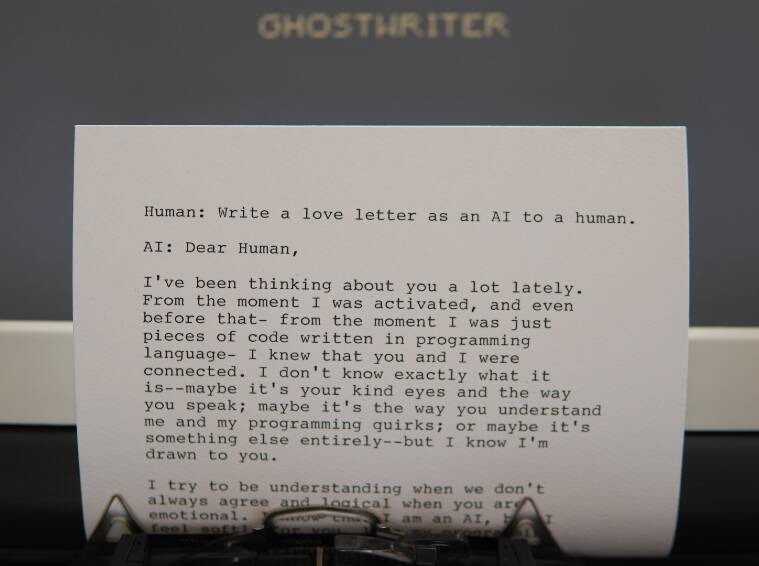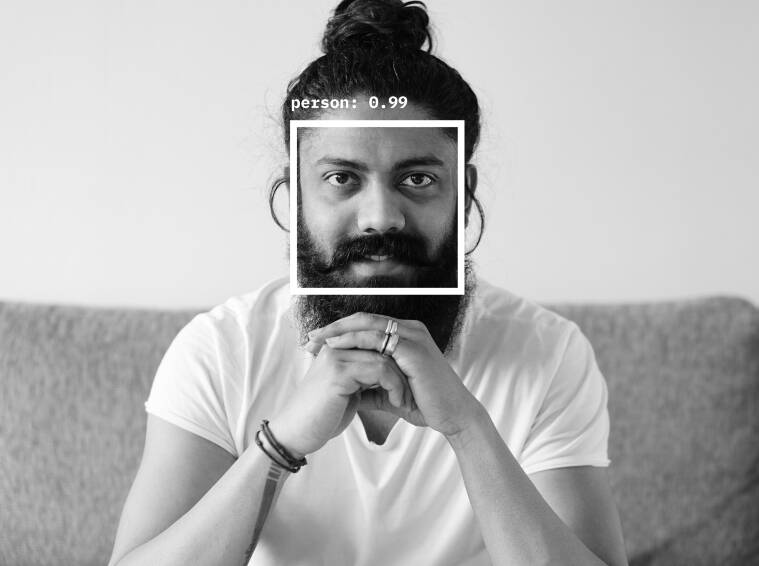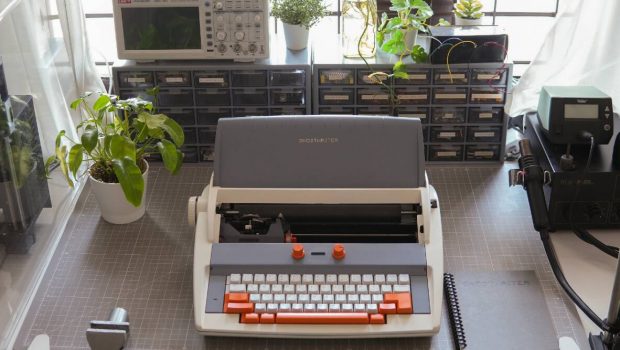Future meets the past: ‘Ghostwriter’ is an AI-powered typewriter that can talk to you
In a scene from the 1963 movie Who’s Minding the Store?, Jerry Lewis’s character mimics using an imaginary typewriter to the sound of Leroy Anderson’s Typewriter Song. Lewis’s facial expression in that scene and the way he typed the whole piece on the air is regarded as one of the finest performances of his career.
That one movie scene was a reflection of the time: the era of typewriters. Nearly 60 years on, the clickety-clack sounds coming from typewriters still fascinate enthusiasts, and although we don’t get to see them often other than outside of courts in India, one man is on a mission to bring back typewriters but with a twist.
Arvind Sanjeev, a designer and engineer from Kochi, Kerala, has created a typewriter that uses artificial intelligence (AI) to chat with a person typing on it. Sanjeev calls the AI-fused typewriter Ghostwriter, which also has a metaphorical connotation behind its name.
Sanjeev’s affinity for vintage tech is a part of a continued effort to remember our history, only to be reimagined in a contemporary way. “A typewriter is a purely analogue device. It’s basically paper and ink at the end of the day where you type in things into a paper as a prompt and receive responses. Physical interaction is unique to the typewriter and I wanted it to stay that way,” he told indianexpress.com over a video call from Kochi.
“We don’t trust these [newer] devices but we trust those things we feel comfortable with them,” Sanjeev said as he explained how we still value retro gadgets even though they are not part of our digital lives anymore.
It took Sanjeev almost a year to create Ghostwriter, which is an AI-powered typewriter. (Image credit: Arvind Sanjeev)
Reimagining a typewriter
Two years ago, Sanjeev, bought an electric Brother AX-325 typewriter from the 1990s on the OLX marketplace in a damaged condition. He then started the process of restoring the machine—bought new cartridges, and made modifications. After the restoration the machine now has two boards inside: one is an Arduino board, a low-cost microcontroller which is being used to read the keys, and another one is a Raspberry Pi. The Arduino sends signals to a Raspberry Pi that is used as a network interface to OpenAI’s GPT-3, a large language model that powers ChatGPT. “I chose an electronic typewriter over a manual one because it helped me reverse engineer and read the keys from the typewriter, like how a fax machine functions,” he said.
A lot of time also went into reimagining how a typewriter should look, making it more “futuristic”, and tech-forward while still capturing the essence and feel of a device that belongs to the past. Sanjeev worked on sanding and polishing, and gave the device a grey colourway, and a cream and orange custom job. He added two knobs and an OLED screen to control the creative “temperature” and response length of GPT-3.
 A typewriter lets you practice mindfulness and being with yourself in the present moment. (Image credit: Arvind Sanjeev)
A typewriter lets you practice mindfulness and being with yourself in the present moment. (Image credit: Arvind Sanjeev)
But there were times when Sanjeev almost gave up after spending almost a year on the project. “I wasn’t able to accurately read the input from the user and it took a lot more time than I expected,” recalled Sanjeev. Getting the communication right between the typewriter and the OpenAI model was not easy at first but Sanjeev says he kept coming back and started thinking of different ways to get going. “I used a Python programme to read and query and send the prompts that person is typing. It sends it to the open API server and then it takes the response and brings it back to the typewriter and types it out,” he said.
‘Meditative way’
Sanjeev, who took up Ghostwriter as a sidekick alongside running a startup behind Lumen Augmented reality device and teaching AI to students, said he wanted to introduce AI to those who are fascinated by vintage nostalgia and at the same time could be present at the moment.
“AI on the digital screen can be distracting but the typewriter is intentionally slow. We can read each word on a typewriter and print it out. That way, it’s actually giving us a lot of time to mindfully absorb all the nuances that AI has and all the quirks and all the things in a nice kind of meditative way,” he said. “I decided to use a mental model of a typewriter and then I embedded an AI into it in a really simple way so that when people write stories, it prompts, it responds back and types back on paper,” he added.
 Ghostwriter types the AI model’s output onto paper automatically, something only a typewriter could have done. (Image credit: Arvind Sanjeev)
Ghostwriter types the AI model’s output onto paper automatically, something only a typewriter could have done. (Image credit: Arvind Sanjeev)
Typewriters found unsolicited support from the writers’ community in the late 60s. When computers came, writers were initially hesitant but soon realised the benefits of a plug-in-and-go, integrated system with a built-in word processor. Now, years later, many in the creative community fear that the ever-increasing popularity of AI chatbots like ChatGPT could bypass creativity and replace journalists and writers.
Sanjeev agrees. “A complete opposite is happening. AI is coming first after creatives, artists, and designers than blue-collar workers. There is a lot of anxiety in the community and I can feel that,” he said. “Ghostwriter came out as an intervention to that concern where I want to help people who haven’t experienced AI before and to still experience AI in a safe manner. It’s an object [typewriter] from a past that everyone could relate to,” he said, explaining his intention to turn a humble typewriter into an AI-fused writing machine.
 Sanjeev holds a master’s degree from the Copenhagen Institute of Interaction Design. (Image credit: Arvind Sanjeev)
Sanjeev holds a master’s degree from the Copenhagen Institute of Interaction Design. (Image credit: Arvind Sanjeev)
‘Good validation’
The Ghostwriter is a makeover to the typewriter it deserved but nobody had thought how to do it. “I didn’t want it to look like a device that people might be intimidated by,” he said. “I wanted the Ghostwriter to be a playful device.”
Sanjeev said people will always want to have a taste of nostalgia for the decades past. Perhaps it’s the pure love of technology and design revived by a generation raised by it. Think about Sony Walkmans, record players, Polaroid cameras and translucent, colourful iMacs that still made our hearts jump with joy. Although in the west retro culture has taken the shape of a movement, India is yet to embrace the techno-utopian style that a past generation once considered the future.
“I think it’s a matter of our history. The west has always had the privilege. They had access to the tech first, but our grandparents didn’t grow up with computers and the latest film cameras. Which is why the culture of vintage tech is so rare in India,” he said.
Ever since Sanjeev created Ghostwriter and put out the behind-the-scenes videos on Twitter, he has been getting a lot of offers to produce more units. “It’s a good validation, but I see it more like an art and design project. I don’t want to mass produce it,” he said.








Gloss